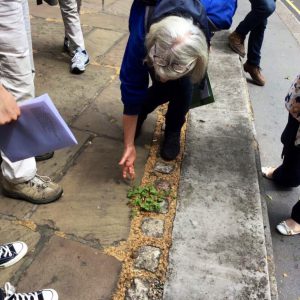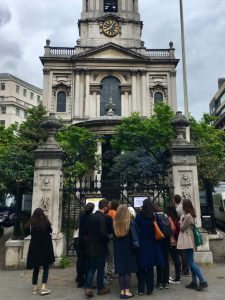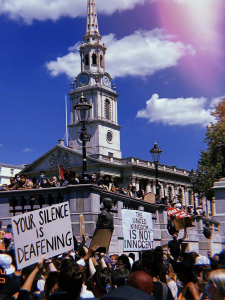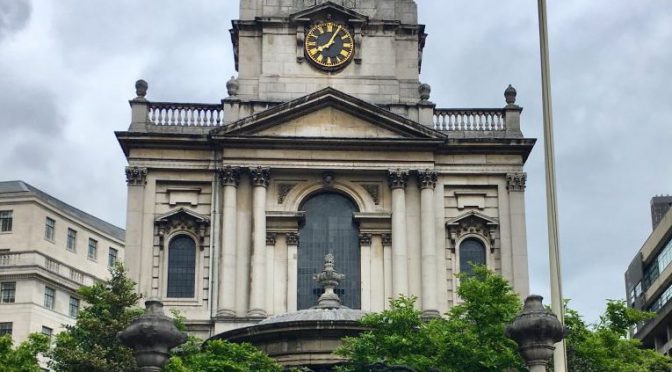By Fran Allfrey, Strandlines assistant editor, English Dept alumna and Teaching Assistant
Strandlines is a life-writing and community history project, which takes the form of a website and linked Facebook, Twitter, and Instagram accounts. The project was set up by Professor Clare Brant, with a board of editors made up of colleagues inside and beyond King’s. I joined as Assistant Editor in spring 2019. With the new term just starting, Clare and I thought now was a good time to reflect on where Strandlines has been, and where it may go next!
Strandlines is dedicated to exploring lives on the Strand—past, present, and creative. This might take the form of any kind of recording of life and impressions from the Strand: written, visual, or even sound or film based. The Strand is a street that so many of us at King’s spend a lot of time on, but often we’re only hurrying through. Strandlines encourages people to pause and show some love to the Strand, its people, and its hidden-in-plain-sight places and histories. The year ahead may see many of us not spending so much time on the Strand, which makes it even more important to stay somehow connected to this special place.

In conversation with Professor Clare Brant Fran Allfrey: It’s great to be able to take some time and reflect on Strandlines at the start of this new academic year! I only joined Strandlines in spring 2019, but Strandlines has a longer history. Could you tell us about how the project first came about?
Clare Brant: When the English department was based in the second floor of the Strand building, I had an office overlooking the Strand. It had a view on to St Mary’s, and a tree. Looking out of my window, it occurred to me that the Strand was and is a really interesting street – it is the artery which connects the City of London with the City of Westminster. And yet it felt unloved: there is no tourist memorabilia as there is for other London streets, no connected thinking which picks up its exceptionally rich history, and no cohesion among the residents, workers, visitors, tourists and of course students and KCL people who come and go on the Strand every day. So I thought up Strandlines. With colleagues in what was then the Digital department and Geography, we applied for a grant to make a website. Other grants enabled us to fund a research fellow: we were lucky to have Hope Wolf, who set ticking various imaginative engagements with parts of the community of the Strand, including homeless people, local residents, and residents of an old people’s home.
FA: Have the aims and scope of Strandlines changed since that first couple of years?
CB: Yes. A couple of the grants were specifically to cultivate community. That intensive work needed a full-time research fellow, so when the grants finished and the fellowship ended we had to recalibrate. As with many online projects, Strandlines suffered a disastrous website corruption, which saw the project go quiet for a while as we tried to recover as many old contributions as we could. Sadly we lost valuable material and impetus. But it catalysed a change of platform and a relaunch.
As Strandlines 2.0, we aim to create and serve a community of writers, artists, and contributors. We’re always looking for ways to build up our community and encourage more people who live, work on and visit the Strand to submit their own writing, videos, or art to record and archive the diverse community on our doorstep, and engage with the past, present and future of this unique street.

FA: Are there any particular highlights from Strandlines (1.0 or 2.0) for you?
CB: Yes: the work we did with The Connection at St Martin’s, for instance in the Rags to Riches walking tour, brought homeless people into King’s for the first time in meaningful ways to share their stories. It was humbling and joyous.
I am also proud of the Cabinet of Artists who in Strandlines 1.0 created fantastic creative work interpreting aspects of the Strand. I’m grateful to Professor Michael Trapp (in the Classics department) for sharing his enthusiasm and knowledge of the ‘Roman’ baths, and to Geoff Browell of KCL Archives who has hosted sessions exploring some of the Archives’ fascinating holdings of Strand-related material.
And it was fun making the Greening Aldwych tour for London History Day in May 2019. We looked at tiny plants, stone, trees, greenery, and some of Aldwych’s monumental buildings, to see a bit of how nature inhabits the Strand’s culture. I also want to give a special mention to the piece by Myfanwy Boudry, who was a Strandliner during her year-abroad at King’s. Her post on life on the RNLI pier on Embankment is fantastic!

FA: What I most enjoy about being assistant editor is getting to meet lots of contributors and going out and talking to people on the Strand. I particularly enjoyed a tour of the Royal Courts of Justice by Alan Read (Professor of Theatre in the English department). I am an architecture and town planning nerd, so it was great listening to Alan’s insights into how architecture shapes the law and the way it is conducted, and vice versa. Getting to sneak around the basements of Somerset House with Jane Levi from the Edible Utopia collective was also a lot of fun.
I interviewed a group called Streetkind, who do outreach work with people living homeless on the Strand. Obviously, it is a scandal that there are people who are abandoned by local authorities and national government, and that self-organised non-profit groups and charities have to step in, but the Streetkind team have built up an amazing sense of community and purpose.
We’ve had so many historical research pieces written in the last year that it’s hard to choose a favourite. Particular highlights include King’s English dept alumna Sarah Mir’s piece on Helen Nontando Jabavu, the first black editor of a magazine in the UK; the development of architecture on Great Queen Street by KCL maths graduate Paul Guhennec; and this piece on 18th-century stargazing by McGill University student (and Londoner at heart) Théophraste Fady.
But I also love the creative work we have published: poems by King’s English students and alumnae Godelieve de Bree, Hannah Clayton, and Laurie Wiegler, and by Ruth O’Callaghan; photography by Dan Kirmatzis; and a short story by Michael Handrick.
As you can see, choosing my Strandlines highlights is like having to choose my favourite book, absolutely impossible.
I wonder, Clare, whether you can share your hopes (and any plans in progress) for the future of Strandlines? Is there more of a particular type of writing, visual work, or projects that you’d like to see?
CB: Digital enables us to give a home to multimedia strands – for instance, short films catching life on the Strand now will quickly become social history. There are so many interesting forms of work taking place on the Strand: it would be great to be able to share more of those.
Life writing can use visual forms inventively too, as in aerial footage and different kinds of street views. It would also be great to have more self-guided walking tour routes to help people pause on the Strand and notice something that is otherwise invisible.
The climate crisis and Covid are changing how we live: I would like to see those issues appear in our strands, with reflective thinking about how we respond to their challenges. Importantly, Strandlines is a home for future aspirations as well as present impressions and past discoveries.
FA: Something that I would like to be able to commission more of are pieces that document the link between the Strand and protest, and ensure that Strandlines archives the diversity of communities that live, work in, and visit the area.
So far, you can find photographs of academic strike placards from spring 2020, Extinction Rebellion’s occupation of Waterloo Bridge in 2019, and the May 2020 Black Lives Matter protests at Trafalgar Square, along with a reflection on BLM by Sarah Mir, which linked the Strand protest to the global issues at stake. The BLM protests happened at a time I was out of London, so I spent time scouring Instagram for photographs. It felt urgent to collect at least some images as the internet is such an unstable archive. It would be even better to collect first-hand accounts from these protests.

I know that others in the editorial team have recommended exploring the political activity and protests associated with Embassies in the area: Zimbabwe House, Australia House, India House, and Gibraltar House. I’d love to preserve memories of summer film screenings, music festivals, and events to mark Diwali, Eid, and Easter at Trafalgar Square.
Finally, there’s more room on Strandlines for memories and stories of working life on the Strand. I have recently interviewed (via Instagram!) Carol and Jenny, sisters who run the independent Vietnamese café on the Strand, and Brian who works at Charing Cross. I’d love to hear more stories: of the florist who works at Embankment tube, bus drivers or bus tour guides, hotel concierges… the list is endless and I will never have time to talk to everyone by myself!
CB: I’d like to reiterate that written, visual, multimedia, and experimental ideas are all welcome. If it can be loaded on the Strandlines website, then we are interested in archiving and sharing it.
Strandlines is always open to one-off contributions – just email contact [at] strandlines [dot] london or use our online form. However from Friday 18 September – Monday 5 October 2020, applications are open for ‘Strandliners’, people who can take on more of a sub-editor role and pursue a project, take on commissions, or devise a series: https://www.strandlines.london/2020/09/18/are-you-a-future-strandliner/
Blog posts on King’s English represent the views of the individual authors and neither those of the English Department, nor of King’s College London.
You may also like to read:

